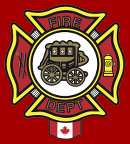Too many people in B.C. die, or become seriously ill, because of carbon monoxide (CO) poisoning. CO is a colourless, odourless and tasteless gas produced by burning carbon fuels such as propane, natural gas, oil, wood, charcoal, alcohol, kerosene or gasoline. Exposure to CO interferes with the body’s ability to absorb oxygen, which can result in serious illness or death. While the effects of CO poisoning can be devastating, they can be prevented. The best things to do is have all fuel-burning appliances inspected by a licensed contractor every year and install a carbon monoxide alarm that signals an alert when the gas is present. If your alarm isn’t hardwired, check your batteries twice a year. And if it’s more than seven years old (check the end of like date), get a new one. Units with sealed lithium batteries require no battery replacement or maintenance.
Carbon Monoxide Awareness Week is (Nov 1 to 7). If you live in RDNO Area B or C, contact BX Swan Lake Fire Rescue to request a home safety evaluation and you could qualify for a free battery-operated Smoke/Carbon Monoxide detector. See the BX Swan Lake Fire Dept. Home Safety Program for more details.
KEY MESSAGES
- Have fuel-burning appliances (furnace, gas range/stove, gas clothes dryer, water heater, portable fuel-burning space heaters, fireplaces, BBQ, and wood burning stoves) installed and inspected regularly by a Technical Safety BC licensed gas contractor. Find a licensed contractor in your area using the online directory at www.technicalsafetybc.ca/find-contractor
- Never use equipment designed for outdoor use, such as barbecues, camp stoves, propane lanterns, generators or lawnmowers, in any enclosed space.
- Remove vehicles and gas-powered equipment from the garage immediately after starting the engine.
- When using a wood-burning fireplace, open the damper and partially open a window or door at the level of the fireplace. Close the damper only after the fire is completely out and ashes have cooled.
- Carbon monoxide alarms, in addition to regular appliance maintenance and functioning smoke alarms, can warn you if CO is present and provide extra protection for your home and family.
- Install carbon monoxide alarms in bedrooms or the hallway near sleeping areas on each level of your home.
- If your CO alarm is battery operated, check batteries at least twice a year.
- Replace all CO alarms according to manufacturers’ instructions.
- If your alarm indicates high CO levels in your home or you suspect carbon monoxide poisoning:
o Open all doors and windows and get outside to fresh air immediately.
o Seek emergency medical attention for symptoms of CO poisoning. Symptoms include flu-like symptoms such as headaches, nausea, vomiting, dizziness, burning eyes, confusion, drowsiness and even loss of consciousness.
o Call 9-1-1 or your local emergency number and your gas service provider’s 24-hour emergency line. Don’t go back in the building until it’s safe.
o Fortis BC:1-800-663-9911
o After returning to the building, have a licensed contractor inspect your gas appliance
HOW TO CLEAN CARBON MONOXIDE DETECTORS
Source – https://homeguides.sfgate.com/how-to-clean-carbon-monoxide-detectors-13419027.html
When cleaning your carbon monoxide detector, take the opportunity to perform other maintenance tasks such as changing the detector’s batteries and pressing the detector’s test button.
Carbon monoxide detectors, an important home safety tool, can alert you and your family of deadly, yet otherwise undetectable carbon monoxide leaks in your home. Much like smoke detectors, carbon monoxide detectors must be regularly maintained so they work properly. With little more than a vacuum cleaner and some canned air, you can keep your carbon monoxide detector clean and in good operational order.
- Wipe down the outside of the detector with a dry, soft cloth. Wipe away any large pieces of dust or debris from the area around the sensor. Slightly dampen the cloth if there are any particularly dirty spots that require extra scrubbing. Don’t moisten the detector’s sensor, however.
- Attach the soft brush attachment to your vacuum hose. Gently vacuum the carbon monoxide detector, focusing on the area around the sensor. Try not to touch the sensor with the hard plastic of the vacuum attachment. The sensor is sensitive and can be easily damaged.
- Spray the area around the sensor with canned air or a gas duster. The canned air will take care of any remaining debris without causing damage to the carbon monoxide sensor.
- Repeat this process once every six months.
Visit www.COsafety.tips, and https://www.technicalsafetybc.ca/public-safety/carbon-monoxide-safety for additional safety tips.
